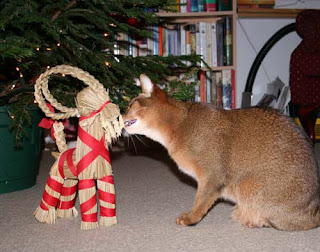The Christmas Goat
The Christmas goat is one of the oldest Christmas symbols in Sweden. Its origins can probably be traced back to the most powerful of the Norse gods, Tor the god of thunder. His carriage was pulled by two goats named Tanngnojst and Tanngrisner (their names can be translated as “he who grinds his teeth” and “he who has big gaps between his teeth”, not very beautiful names if you ask me).
Up until the 19th century young men would dress up as goats around Christmas time and go from house to house, sing songs and put on spectacles and plays for which they would receive money or food in return. The poorer ones would save the money for the upcoming school term, whereas the wealthier ones would have a big party in the days between Christmas and New Year.
In some ways the tradition of the Christmas goat can be viewed as the social benefits system of its time. Christmas time was the only time of the year when begging was allowed, and the wealthier homes were expected to give generously to the performing goats.
From the beginning of the 19th century the Christmas goat served as an earlier version of Father Christmas, where the man of the house would dress up and hand out gifts to the children. Sometime towards the end of that century the goat was replaced by jultomten and the goat more or less disappeared altogether. But since the 1940s most Swedish homes have a pair of goats made from straw under the tree at Christmas. We only have one, and he doesn’t seem to be grinding his teeth nor have particularly big gaps between them; instead he is constantly abused by Heinz and Nar, who love to nibble on his beard and horns.







No comments:
Post a Comment